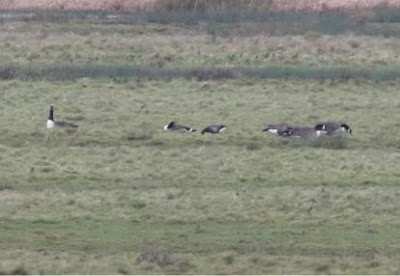 |
| Sparrowhawk at second screen (c) Bark |
This was a weekend with two very different contrasting
mornings. Saturday was grey, misty and with a fine drizzle. The rain got on bins
scopes and cameras, and for me it made seeing through my glasses very tricky.
Goldcrest in the mist (c) Bark
Sunday
however was the very best kind of winters morning, with bright sunshine, clear
blue skies, temperatures just above freezing and birds seemingly everywhere.
Lapwings over Big Otmoor (c) Bark
One of the best things on Sunday morning after coming through the Car park Field was finding that some of the White-fronted Geese were feeding quite close to the cattle pens.
 |
| White fronts (c) Bark |
They were with Canada Geese and Greylags but did not seem unduly nervous of us on the bridleway. We counted approximately twenty or so of them on Greenaways and a similar number at the top of Ashgrave. Unfortunately, we could find no sign of the Brent Goose that was seen last week, and we assume it has moved on.
 |
| The size difference between the Whitefronts and Greylags is very Noticeable (c) Bark |
Both Hen Harrier and Marsh Harrier were seen at the weekend, but I didn't connect with the Hen Harrier.
 |
| Marsh Harrier (c) Tom N-L |
I did, however, get very lucky with a Sparrow Hawk. Just as I was about to leave the second screen, with my scope on my shoulder, I glanced out at the lagoon for one last time and as if from nowhere a Sparrow Hawk landed on the fence post outside, not more than two metres away.
 |
| Sparrowhawk (c) Bark |
I managed to fire off six pictures one handed, before it saw me and flew. On Sunday morning we were lucky enough to see a Peregrine bathing in the flood on the further edge of Noke Sides it spent at least five minutes in the water splashing about and flapping its wings, it then flew up into one of the adjacent Oak trees to preen.
 |
| Distant bathing Peregrine (c) Bark |
When we looked more closely, we could see that there was another Peregrine with it in the tree. Scope views showed that there was pale fringing on the smaller of the two and it appeared slightly more brown than slaty grey, and so we assumed that it was a juvenile.
 |
| Redpoll (c) Bark |
Walking along the bridleway on Sunday morning we came upon a small party of five redpolls feeding. They were on one of their favourite food plants Rose Bay Willow Herb. It was difficult to pick them out and could so easily have been overlooked, given their size and from behind their extremely effective camouflage.
 |
| Their camouflage in the dried grasses is superb (c) Bark |
Increasingly Redwings and Fieldfares are feeding on
the ground as the berries are all gone. Some Redwings in particular are becoming
less nervous and more confiding as they forage in the short grass beside the paths.

Confiding Redwing (c) Bark
Bullfinches are changing their feeding strategy too and are beginning to change
from picking seeds from dried up blackberries to eating the swelling buds of
Blackthorn bushes. They can most easily be seen doing this in the larger bushes
of the car park field.
Bullfinch on blackthorn (c) Bark
It is surprising how we take some birds for granted and don’t always appreciate their colour or their beauty. A careful, close look at a Starling or a Chaffinch reveals amazing colour and structure, because they are so common, we sometimes overlook them.
 |
| Starling (c) Tom N-L and Chaffinch (c) Bark |
As I have been writing this morning, news has come
in that three Cranes have been seen over Greenaway's and headed towards Noke Sides.
Cranes have been heard in the past few days at other sites in the county and
these birds may be the same ones. 
Stonechat along the bridleway (c) Bark
Until we get a good look at them and can see leg
ring colours we will not know if they are “our” birds returning It seems to be
very early for our breeding cranes to come back as last year they returned on
fourteenth of February, which itself was earlier than the year before. More
information will follow when I have it.
 |
| Like winter watercolours (c) Tom N-L |





















